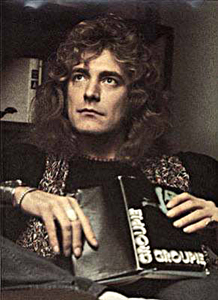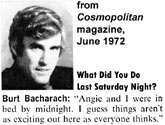
I’ve now watched Robert Plant’s Conan O’Brien appearance 5 times. His new record, Mighty Rearranger, is so flawless that it will only sell about 3,000 copies. As great as the album is, Robert Plant and the Strange Sensations are magnificent on stage; there is no currently-touring rock band that even comes close to their dynamic perfection. That Plant is so much better live than on record is a delicious reversal of his Led Zeppelin days.
Zeppelin’s live album, The Song Remains The Same, just sucks, as do any live bootlegs I’ve heard. The studio albums are like a full-tilt, amphetamine orchestra, while the live album is like reducing the orchestra to only tympani and clarinet, with the clarinetist going on for hours! The band was adamantly a 4-piece on stage, thus making it impossible to recreate that album sound, so they took it in a different direction, honoring the distinction between studio and stage. Many wax poetic about seeing Led Zeppelin live, but it just didn’t translate well past that moment.
That makes sense, though, because Jimmy Page was a Studio Merlin the Magician. He’s remembered as a Guitar God, but I think many confuse his brilliant production work with his guitar prowess. Those indelible images of his skinny body arched back from the Gibson banging at his knees are the silhouette of an ax slinger, and I’m not questioning his 6-string authority, but when thinking of Zeppelin, we think of the way those albums - those songs - sound, and no one has ever sounded like that.
Each Zeppelin track was an expansive, elaborate production, with Page weaving a mad web of sounds that had nothing to do with a blues rock outfit, and everything to do with moving the Phil Spector Wall of Sound into the macho world of hard rock.
“Four Sticks,” from Led Zeppelin IV, is a prime example of his studio wizardry. The central riff and vocal line is a standard blues wallow until you double the speed, throw in a jungle beat and a loose, liquid bridge. That’s Page arranging. Triple track and condense the electric guitars until they buzz like hornets, fatten up the bass sound like Kirstie Alley, round out the drum so it sounds like tomcats fighting inside a velvet bag, and nudge the pitch control ever so slightly every time Plant careens into a squeal, and that’s Page producing. Break down the basic parts of that song, and it’s nothing special, but after Page stirs the ingredients, it becomes a vital piece of music that still sounds fresh and unique to this very moment.
Page turned the extraordinary into something extraterrestrial. Think of the opening drum riff on “When The Levee Breaks”: Jimmy knew how to make it sound like Bonham was beating sequoia trunks against the floor of the Grand Canyon. No way did it ever come across like that live, but who cares? Jimmy knew it was more important to get the ultimate sound recorded for all eternity rather than worry about acoustics in cement hockey arenas.
That he was such a production genius is not a surprise, considering his studio-musician-for-hire background. That he is usually over-looked for being a production genius is entirely his doing. You’d think the band was being charged a dollar a word for album liner notes because they were so scarce, and it concealed the less glamorous mechanics of the band while contributing to the mystery. Jimmy Page fully understood the yin and yang of the Zeppelin legend, and instinctively knew that the ponderous technical details of studio yin would seriously muss the aggressive Zeppelin yang, so he kept it quiet. Hell, he’s still quiet about being one of the greatest rock producers of all time, almost as if he doesn’t realize it was his greatest talent, his surest shot at immortality.
Page dried on the vine after Led Zeppelin disbanded, and Plant blossomed. He has successfully explored varied forms of musical expression with humor, grace and dignity. He works only when he feels impassioned to do so, and having no financial worries, can maintain the quality standards of his musical pedigree by hiring only the very best musicians.
One of his greatest achievements is giving the Zeppelin catalog proper live treatment by giving it full-bodied instrumentation. In the mid 90’s, he dragged Jimmy Page out of his hermit castle for a triumphant rethink of their musical partnership on the Page & Plant tour. In 2002, we saw him and his other-worldly band blaze through a spellbinding show. The personal highlight of that set was a version of “Four Sticks” so thunderous and primal that it literally knocked me back in my seat.
Robert Plant conjures and improves the magical Led Zeppelin album sound, and it’s not the reason for his being, but rather another reason he is a master.







